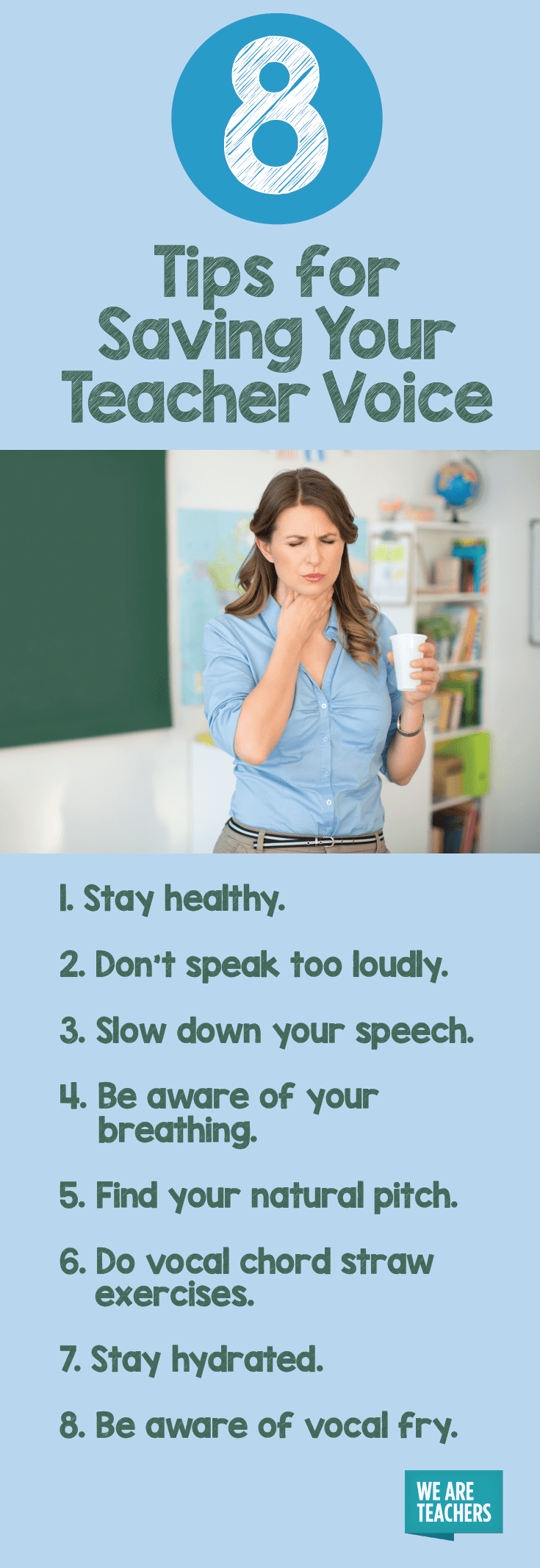Losing our minds as teachers? No big deal, we lost ours long ago. (Kidding!) But losing your teacher voice, well, that’s a true occupational hazard. We spoke with voice teacher and coach Mollie Bennett Weikert who provided essential and easy-to-follow tips on how teachers can preserve their vocal chords.
1. Stay healthy.
The quickest route to a fragile, hoarse voice is through a cold, so those sickness-avoiding techniques we utilize during cold and flu season are critical for voice preservation year-round.
Keep your hands—those germ conduit culprits—away from your eyes, nose and mouth, and keep them as clean as possible. Get optimum sleep and follow a healthy diet (easier said than done, we know).
2. Don’t speak too loudly.
Yelling is the easiest way to wreck one’s voice, so utilize whatever strategies you can to keep loud speech to a minimum. If your classroom is exceptionally rowdy, get a bell or other signal to quiet your class without attempting to holler over them.
When speaking at assemblies or multi-classroom gatherings, take the administrative steps to achieve a microphone. It only takes one afternoon of calling across a crowded cafeteria for a sore, strained voice days after.
3. Slow down your speech.
One of the most common ways we strain our voices, says Weikert, is by talking too quickly. “Although teachers have a lot of tell their students, speaking really fast keeps the vocal chords tense and tight, and that is when damage can occur.” Making an effort to always speak in a normal pace will keep our voices strong.
4. Be aware of your breathing.
Throughout the school day, check in with yourself to make sure your breath is regular and steady. Weikert recommends that we think about our breathing before sleep as a guide.
At the end of the day, when laying down, our abdomens expand as we draw breath in and deflate as we exhale. We should aim for that breathing style throughout our hectic days.
5. Find your natural pitch.
The more we speak at the pitch level that our voice is accustomed too, the less likely we are to strain. Our best speaking pitch is not the highest or lowest pitch in our natural range, it is in the middle.
Teachers often may speak lower than natural for a more authoritative sound, or higher than natural to convey friendliness. Both adjustments can overuse the voice.
Instead, aim for the sound range that comes to your voice naturally, such as the tone of your voice when you spontaneously say “uh-huh.” The top note of your “huh” typically reflects your natural and optimum speaking pitch. If the voice you use to speak in the classroom differs from your natural pitch, you could be straining.
6. Do vocal chord straw exercises.
If a hoarse, strained or lost voice is a regular occurrence, add vocal exercises using a simple drinking straw to your day. These simple exercises take just a few minutes per day but can make a big difference in voice preservation. Weikert recommends this video and more straw voice exercises on YouTube as great places to start.
7. Stay hydrated.
Keeping your voice, as well as your body, hydrated through drinking lots of water is key. Coffee does not count, and caffeinated beverages can have the opposite effect and dry out our voices. Water lubricates the vocal chords, preventing wear and tear.
8. Be aware of vocal fry.
Young women (and those of us who may want to connect with young people) are most likely to use the voice pattern of vocal fry. Think of a Kardashian sister saying “Sooo cuuuute.”
This low, creaky voice vibration is caused by a fluttering of the vocal chords that abuses them, truly frying our voices. Weikert says that this speaking style is high damaging to vocal chords, and can cause vocal nodules and every day hoarseness.


